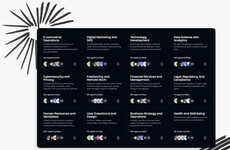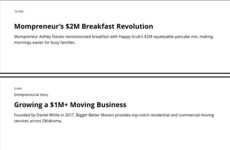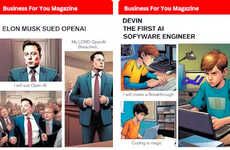
In this interview, Andrew Dobrow, editor of Gearfuse, refers to his writing as “Loud, vulgar, and excited.” There’s no better way to describe the way in which Andrew writes about gadgets.
While the name Gearfuse may suggest it is a blog about technology, the site is more of a collection of all things entertainment. Andrew Dobrow talked with us about the role trend spotting plays in his work with Gearfuse.
12 Questions with Andrew Dobrow
1. How did you get involved with Gearfuse and what motivates you to continue?
It’s funny actually. I first got involved with Gearfuse in mid-2007 when I saw an ad for available writing positions. I don’t remember where the ad was now, but that doesn’t matter much in the story. The interesting part is that, initially, I was denied a spot on the Gearfuse staff. But as bloggers started to drop like flies, the Gearfuse publisher, Steve Rufer, e-mailed me and offered me the position. The rest is history.
Since late 2007, Steve and I created what is now Gearfuse. The site has changed considerably from its inception as I fell into my writing groove. It was my first real blogging position, so I had to find my voice. And boy, did I find it. Loud, vulgar and excited.
I’m constantly motivated by the progression of the industry. The increased involvement of our readers is one of the only incentives I need, though it’s really a thrill to see all of the numbers go up as time goes on. It just takes time.
2. How significant are the topics of cool hunting and trend spotting to Gearfuse?
Spotting trends before they’re trends I think is the key. You have to have a feel for the overall zeitgeist of your Internet audience. What sort of stuff does your audience dig? I’m lucky enough to share common interests with my audience, so I pretty much post up what ever I think is awesome and upcoming.
And the key to finding unique and potential trend items? A hell of a lot of research. Follow any site you can, even if they only deliver something valuable once a month. It’s worth it in the long run to have a clogged RSS reader. You gotta put in the hours though. Interesting stuff doesn’t typically just jump out at you.
3. How do you define a trend?
To define a trend, all you have to do is surf the web. Trends are frequently-discussed and often-posted items of zeitgeisty goodness. I mean, you can take all of the theories you have, such as something occurring a certain amount of times before it’s actually a trend, but what does it matter? A trend is a trend whenever people realize the trend is actually a trend.
The point is, whether something is a trend or not bears little meaning on the item's future. What can you do with the trend to make it trendier? What can you add to put the item over the edge of trendom?
4. How do you define cool?
Creativity is cool. Innovation is cool. The ability to set aside constraints to produce is really, really cool. You have to think about ways to say something that hasn’t been said before. Tired cliches are not cool. An open-mind and open eyes, now that’s cool.
Anything that inspires me is cool.
5. Do you need a culture of innovation to create something that is cool?
I think you need to create your own culture of innovation. Don’t be so concerned about what the other guy is doing. Do your own thing. If someone else is doing something similar, than why would an audience come to you rather than the other guy? Feel free, be innovative. Coolness comes automatically.
6. What is the best way to create an infectious idea, product or service?
Stop thinking and actually do it. I know that sounds easy, but people have great ideas all of the time and do absolutely nothing about them. The key to being infectious is taking the risk. Doing what needs to be done. Spreading the word about the awesomeness about your product. Having full faith in your own awesomeness.
7. What is the key to innovation?
Again, you have to deny that cultural restraints exist. Be vulgar if you want to be vulgar. Be ultra-saccharine if you feel like being sweet. Innovation doesn’t always have an audience. Don’t confuse innovation and trending. When the two coincide, you’re extremely lucky.
8. What is the most important trend you see in your industry?
I’m seeing a lot of aggregation--sites like Trend Hunter and Buzzfeed, which take the hottest of the hot and place them all in one place. In a way, these trend and buzz sites are keeping us bloggers on our toes. There’s no more sitting back on our laurels. We have to actively seek buzzyness. If not, you wind up late, and a trend is only a trend long enough to be called a trend once. After that, forget about it, the trend is tired.
9. What are your ambitions for Gearfuse?
With my unbound confidence, the sky is always the limit. In fact, forget the sky, there are no limits. If you believe in what you do and you enjoy your work enough to put in the hours, nothing can hold you back. Gearfuse will only gain in viewers and gain in citations.
10. How do you reset yourself to be creative? Do you have any rituals?
I don’t really have time to set aside for creativity because my life and job are based in constant creativity. Blogging is a super-fast industry and you need to have fast ideas and speedy research skills. I’ll sometimes get myself pumped up by reading some of my favorite bloggers, but for me, the creativity starts to flow right when I open up the flood gates.
Of course, I get writer’s block from time to time and there are days where I don’t feel like doing much of anything. But work through it. As Nike has been known to say, Just Do It.
11. Professionally, what do you want to be doing in 10 years?
I’d like to be doing pretty much what I’m doing now, I suppose. Maybe expand my horizons a bit, do some more reviewing. Hopefully I’ll have people interested in me reviewing their creations. I wouldn’t mind getting paid a bit more, but who wouldn’t?
12. What are your most important hobbies?
Reading is the number one key to anyone interested in writing. Read as much as possible on as many topics as you can stand. I read everything from books on physics to cultural manifestos to beach fiction, and every bit helps. Learn how to enjoy the hunt. Learn how to love researching and read, read, read.
While the name Gearfuse may suggest it is a blog about technology, the site is more of a collection of all things entertainment. Andrew Dobrow talked with us about the role trend spotting plays in his work with Gearfuse.
12 Questions with Andrew Dobrow
1. How did you get involved with Gearfuse and what motivates you to continue?
It’s funny actually. I first got involved with Gearfuse in mid-2007 when I saw an ad for available writing positions. I don’t remember where the ad was now, but that doesn’t matter much in the story. The interesting part is that, initially, I was denied a spot on the Gearfuse staff. But as bloggers started to drop like flies, the Gearfuse publisher, Steve Rufer, e-mailed me and offered me the position. The rest is history.
Since late 2007, Steve and I created what is now Gearfuse. The site has changed considerably from its inception as I fell into my writing groove. It was my first real blogging position, so I had to find my voice. And boy, did I find it. Loud, vulgar and excited.
I’m constantly motivated by the progression of the industry. The increased involvement of our readers is one of the only incentives I need, though it’s really a thrill to see all of the numbers go up as time goes on. It just takes time.
2. How significant are the topics of cool hunting and trend spotting to Gearfuse?
Spotting trends before they’re trends I think is the key. You have to have a feel for the overall zeitgeist of your Internet audience. What sort of stuff does your audience dig? I’m lucky enough to share common interests with my audience, so I pretty much post up what ever I think is awesome and upcoming.
And the key to finding unique and potential trend items? A hell of a lot of research. Follow any site you can, even if they only deliver something valuable once a month. It’s worth it in the long run to have a clogged RSS reader. You gotta put in the hours though. Interesting stuff doesn’t typically just jump out at you.
3. How do you define a trend?
To define a trend, all you have to do is surf the web. Trends are frequently-discussed and often-posted items of zeitgeisty goodness. I mean, you can take all of the theories you have, such as something occurring a certain amount of times before it’s actually a trend, but what does it matter? A trend is a trend whenever people realize the trend is actually a trend.
The point is, whether something is a trend or not bears little meaning on the item's future. What can you do with the trend to make it trendier? What can you add to put the item over the edge of trendom?
4. How do you define cool?
Creativity is cool. Innovation is cool. The ability to set aside constraints to produce is really, really cool. You have to think about ways to say something that hasn’t been said before. Tired cliches are not cool. An open-mind and open eyes, now that’s cool.
Anything that inspires me is cool.
5. Do you need a culture of innovation to create something that is cool?
I think you need to create your own culture of innovation. Don’t be so concerned about what the other guy is doing. Do your own thing. If someone else is doing something similar, than why would an audience come to you rather than the other guy? Feel free, be innovative. Coolness comes automatically.
6. What is the best way to create an infectious idea, product or service?
Stop thinking and actually do it. I know that sounds easy, but people have great ideas all of the time and do absolutely nothing about them. The key to being infectious is taking the risk. Doing what needs to be done. Spreading the word about the awesomeness about your product. Having full faith in your own awesomeness.
7. What is the key to innovation?
Again, you have to deny that cultural restraints exist. Be vulgar if you want to be vulgar. Be ultra-saccharine if you feel like being sweet. Innovation doesn’t always have an audience. Don’t confuse innovation and trending. When the two coincide, you’re extremely lucky.
8. What is the most important trend you see in your industry?
I’m seeing a lot of aggregation--sites like Trend Hunter and Buzzfeed, which take the hottest of the hot and place them all in one place. In a way, these trend and buzz sites are keeping us bloggers on our toes. There’s no more sitting back on our laurels. We have to actively seek buzzyness. If not, you wind up late, and a trend is only a trend long enough to be called a trend once. After that, forget about it, the trend is tired.
9. What are your ambitions for Gearfuse?
With my unbound confidence, the sky is always the limit. In fact, forget the sky, there are no limits. If you believe in what you do and you enjoy your work enough to put in the hours, nothing can hold you back. Gearfuse will only gain in viewers and gain in citations.
10. How do you reset yourself to be creative? Do you have any rituals?
I don’t really have time to set aside for creativity because my life and job are based in constant creativity. Blogging is a super-fast industry and you need to have fast ideas and speedy research skills. I’ll sometimes get myself pumped up by reading some of my favorite bloggers, but for me, the creativity starts to flow right when I open up the flood gates.
Of course, I get writer’s block from time to time and there are days where I don’t feel like doing much of anything. But work through it. As Nike has been known to say, Just Do It.
11. Professionally, what do you want to be doing in 10 years?
I’d like to be doing pretty much what I’m doing now, I suppose. Maybe expand my horizons a bit, do some more reviewing. Hopefully I’ll have people interested in me reviewing their creations. I wouldn’t mind getting paid a bit more, but who wouldn’t?
12. What are your most important hobbies?
Reading is the number one key to anyone interested in writing. Read as much as possible on as many topics as you can stand. I read everything from books on physics to cultural manifestos to beach fiction, and every bit helps. Learn how to enjoy the hunt. Learn how to love researching and read, read, read.
Trend Themes
1. Spotting Trends - Opportunities for identifying emerging trends and sharing them with an audience to stay ahead of the curve and offer unique content.
2. Aggregation Sites - The rise of sites that curate the hottest trends and buzz, posing a challenge to bloggers to actively seek out buzzworthy content.
3. Innovation and Creativity - Emphasizing the importance of embracing innovation, thinking creatively, and setting aside cultural constraints in order to stand out in the industry.
Industry Implications
1. Blogging - Opportunities for bloggers to tap into trend spotting and aggregation to create unique and engaging content that captivates their audience.
2. Entertainment - The entertainment industry can benefit from spotting trends early and offering innovative and creative products and services that resonate with consumers.
3. Technology - The fast-paced technology industry can leverage trend spotting to identify emerging technologies and use innovative approaches to stay relevant and ahead of the competition.
1.9
Score
Popularity
Activity
Freshness























